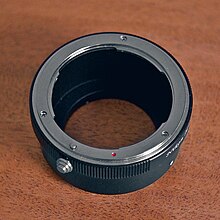


In photography and videography, a lens adapter is a device that enables the use of camera and lens combinations from otherwise incompatible systems. The most simple lens adapter designs, passive lens adapters provide a secure physical connection between the camera and the lens. Some passive adapters may include a mechanism for manual iris control. So called, active lens adapters will include electronic connections, enabling communication between the lens and the camera.[1]
Some lens adapters include a special optical element called a telecompressor, focal reducer, or more recently a "speed booster", a genericised trademark that refers to the Metabones Speed Booster line of lens adapters.[2] This type of adapter is designed to reduce focal length, increase lens speed, and in some instances improve MTF performance. Another innovator in the field is KIPON, a German/Chinese co-operation between Kipon and IB/E Optics.[3] Another branch of lens adapters include an ND-filter to simplify changing lenses, which HolyManta introduced in 2013.[4]
The depth-of-field adapter (also called a DOF adapter or 35 mm adapter) is a largely obsolete device that uses a ground glass focusing screen to enable the use of interchangeable lenses on a fixed lens camcorder.[5] There are also lens adapters made for other optical systems, including microscopes and telescopes.
- ^ Plant, Ian. "Lens Adapters: An Introductory Guide", 11 February 2013.
- ^ Metabones Speedbooster Tele-Compressor Speeds Up Mirrorless Cameras
- ^ "Kipon Adapter Finder".
- ^ http://holymanta.com/
- ^ Bloom, Philip. "35mm Adapters" Archived 2014-12-31 at the Wayback Machine